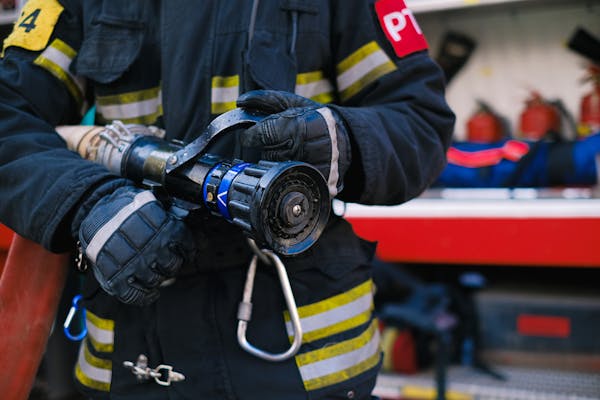You never know when disaster may strike, but with advancements in technology, there’s hope for a safer tomorrow. Imagine a scenario where you’re caught in a fire emergency – seconds count, and every decision can be a matter of life or death. Fortunately, technology is here to lend a helping hand, providing crucial tools and systems that can save lives in the face of danger.
This article aims to explore how technology serves as a vital ally during fire emergencies.
Early Detection Systems
Modern early detection systems are equipped with wireless technology, enabling seamless integration into existing infrastructure. These systems can be remotely monitored, providing real-time alerts to emergency responders.
Thanks to technological advancements, wireless fire detection systems have emerged in the market, offering increased efficiency in extinguishing fires. According to Verified Market Research, the market size for these systems reached $322.99 million in 2024.
Moreover, the market is expected to reach $561.64 million by 2031, with a CAGR of 7.18% from 2024 to 2031. The expanding market signifies a shift towards proactive approaches to fire safety, emphasizing the crucial role of early detection in saving lives.
Real-Time Monitoring and Alerting
Real-time monitoring and alerting systems continuously monitor environmental conditions and fire parameters, providing instant alerts when abnormalities are detected. Advanced sensors integrated into these systems enable real-time data collection and analysis. They detect changes in temperature, smoke levels, and gas concentrations, ensuring early detection of fire incidents.
Real-time monitoring and alerting systems play a crucial role in fire emergencies. These systems continuously track environmental conditions and fire progression, providing instant updates to stakeholders. Emergency responders can swiftly assess the situation and deploy resources accordingly.
In addition to facilitating rapid response, real-time monitoring and alerting systems aid in making informed decisions. For example, they can help occupants choose the right fire extinguisher type based on the nature of the fire. This is significant because selecting inappropriate fire extinguishers has led to fatalities and chronic health issues among firefighters.
An example of this is aqueous film-forming foam (AFFF), which contains harmful PFAS chemicals. TruLaw asserts that these chemicals, termed PFAS or forever chemicals, exhibit persistent properties. Studies indicate that PFAS can endure in both the environment and the human body indefinitely, posing significant health risks. Exposure to AFFF may result in conditions such as cancer, neurological disorders, miscarriages, and birth defects.
These circumstances can result in unwelcome financial, physical, and emotional burdens. To address these challenges, affected individuals can seek assistance from a personal injury attorney. These legal professionals can aid them in pursuing an AFFF lawsuit to obtain the compensation they deserve for their damages.
Automated Fire Suppression
Automated fire suppression systems play a crucial role in mitigating fire emergencies. These systems automatically detect and extinguish fires without human intervention.
Equipped with advanced sensors and actuators, automated fire suppression systems detect fires in their early stages. Once a fire is detected, these systems release extinguishing agents such as water, foam, or gas to suppress the flames. This rapid response reduces the risk of injuries and fatalities and protects valuable assets.
These systems can be customized to meet specific needs, such as the type of fire and the size of the area to be protected. This versatility ensures optimal performance and effectiveness in diverse fire emergency scenarios.
As per Future Market Insights, the worldwide market size for automatic fire suppression systems (AFSS) is predicted to exceed $17 billion by 2022. Moreover, the market would experience a healthy growth rate of 5% from 2022 to 2032.
The rising concerns about employee safety in industrial and commercial sectors are driving the sales of AFSS. This trend emphasizes the importance of proactive fire safety measures in these environments. As organizations prioritize the well-being of their workforce, they’re increasingly adopting automated fire suppression systems to mitigate the risks associated with fire emergencies.
Remote Sensing and Drones
Utilizing remote sensing and drones is crucial in fire emergencies. They can quickly capture images and data to inform firefighting strategies. These drones offer real-time monitoring of the fire’s progression, helping firefighters make informed decisions. This aerial perspective allows for better resource allocation and more effective deployment of firefighting personnel.
Furthermore, remote sensing technology enables the identification of hotspots and potential fire-spread areas. By detecting heat signatures and changes in temperature, it helps predict fire behavior and anticipate its movement. This proactive approach enables firefighters to contain the fire more efficiently and prevent it from spreading to nearby areas.
Smart Building Design and IoT Integration
Implementing smart building design and integrating IoT is vital in fire emergencies. Smart buildings utilize sensors and connected devices to monitor environmental conditions and detect fires.
By connecting fire alarms, sprinkler systems, and emergency lighting, IoT ensures coordinated response efforts. This integration streamlines emergency procedures and improves the effectiveness of evacuation protocols.
Moreover, smart building design incorporates features such as fire-resistant materials and compartmentalization. These design elements help contain fires and prevent their spread, minimizing damage to property and reducing risks to occupants. Additionally, IoT-enabled systems can remotely control building systems, allowing for automated responses to fire emergencies.
Data Analytics and Predictive Modeling
Harnessing data analytics and predictive modeling is crucial in fire emergencies. Analyzing data allows for the early detection of fire hazards and the prediction of fire behavior. By analyzing historical data and current conditions, firefighters can prioritize areas at high risk of fire outbreaks. This proactive approach enhances response times and reduces the likelihood of casualties.
Firefighters encounter various hazards when entering burning structures, including extreme temperatures, smoke, and toxic gases, which can endanger their safety and hinder their effectiveness. Accurate information about the fire site is crucial for informed decision-making, reducing risks and casualties.
The study published in ResearchGate introduces advanced technologies, such as deep learning and predictive modeling, to classify fire site danger and predict temperature changes. By providing real-time data analysis, these techniques empower firefighters to assess risks and plan their actions accordingly.
Despite potential accuracy limitations, the research underscores the potential of these technologies in enhancing firefighter safety and decision-making during emergencies.
Frequently Asked Questions (FAQs):
How Does Technology Help Us Save From Fire?
Technology aids in fire safety through early detection systems, real-time monitoring, and automated suppression methods. These innovations enable swift response, informed decision-making, and efficient evacuation, ultimately saving lives and minimizing property damage.
What Kind of Technology Is Used by Firefighters?
Firefighters utilize advanced technology such as thermal imaging cameras, communication systems, and protective gear. These tools enhance situational awareness, facilitate coordination, and ensure their safety in demanding environments.
What Are the Three Strategies Employed To Extinguish Fires?
Firefighters employ three main techniques to combat fires: direct attack, indirect attack, and combination attack. Direct attack involves applying water or extinguishing agents directly onto the flames. Indirect attack focuses on controlling the fire’s spread by creating barriers or removing fuel sources.
In conclusion, the integration of technology in fire emergencies is invaluable. From early detection systems to predictive modeling, these innovations enhance response times, aid in informed decision-making, and ultimately save lives. By harnessing the potential of technology, we can mitigate the impact of fire emergencies and protect communities more effectively.




